Do You Deliver?
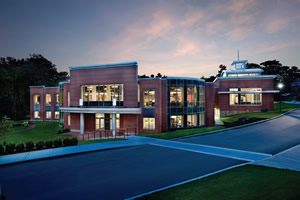
PHOTOS © SHELLY HARRISON PHOTOGRAPHY
One thing is clear; your school needs a new facility.
The rest, however, is a bit murky. How will we pay
for it? Where will we put it? Should we renovate what we
have or build something new? Whether it’s a large public university
or a small private college, schools today have questions when
proposing, funding and delivering construction projects.
They also have options. Innovative funding models and close
construction management partnerships offer schools choices and
advantages — along with a few pitfalls. Check out these options
before you break ground on your school’s next project.
P3: Funding of the Future?
Public-private partnerships, or P3s, have been used to fund
large transportation and infrastructure projects for many years.
Now schools are getting on board. The University of California
has developed many projects using P3, according to a paper by law
firm Hanson Bridgett, including the Neurosciences Building at
the UCSF campus. Construction and development giant Skanska
reports that UC Merced plans to fund its ambitious expansion,
doubling its size with some 1.9 million square feet of academic,
housing and research sites with P3.
The biggest benefit of the P3 model
seems obvious: it offers improved access
to capital. Terrence Gilbride, partner at
Hodgson Russ LLP, explains in a paper that
this kind of “private capital is particularly
useful as the first dollars into a project, for
things like feasibility studies, predevelopment
activities and architectural services —
the things that are needed to take a proposal
from a mere idea to an achievable project
with finite cost and time parameters.”
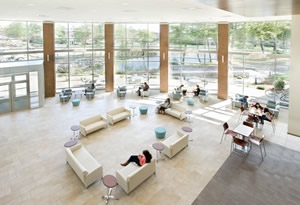
PHOTOS © SHELLY HARRISON PHOTOGRAPHY
WITH A LITTLE HELP FROM MY FRIENDS. Endicott College, a small, private college in Beverly, MA (seen on these pages), has constructed more than 12 buildings on its campus since
2008 within a successful partnership with Windover Construction that includes the full range, from pre-design through construction services. Responses to a recent survey by College
Planning & Management indicate that almost 80 percent of respondents have funded and/or built campus facilities through P3 partnerships. One of the main benefits of a P3 is the
transfer of risk (e.g., operating, maintenance, design, construction and rehabilitation costs, financing rates and timing) to the private sector. Projects can be developed and built with a
high level of certainty for cost, schedule, quality, availability and service.
Gilbride notes other advantages to P3,
like offering schools an opportunity to
invest in projects that can’t be funded with
public money, accelerated project development,
access to incentives and project
delivery flexibility.
The model also allows colleges to focus
their limited energy and resources on what
they do best. “A school’s core mission is
academics and research, not necessarily
providing beds,” explains Orion Fulton,
senior manager, Arup Transaction Advice.
Fulton goes one step further, explaining
P3’s ultimate advantage. “There’s a lot
of nuance to it, but a P3 can keep a project
off of a school’s balance sheet.” This means
projects can still be delivered even if a
school doesn’t want to or simply cannot
increase its debt.
Even with these advantages and successes
by major players, there are pitfalls
and limitations to using the P3 model.
Firstly, it may require special legislations,
as explained by Gilbride. “Most public
college and university P3 arrangements
are structured through a combination of
leases, operating agreements, occupancy
agreements or other contractual arrangements
between the public institution and
a third-party. In more heavily regulated
states, though, public institutions do not
have the inherent power to lease or convey
their property, or enter into agreements
with private development partners, without
complying with cumbersome public land
disposition requirements.”
In other words, it’s complicated. And
that added layer of complexity could be offputting.
“A university has to have the staff
and resources to negotiate a good deal,”
says Fulton.
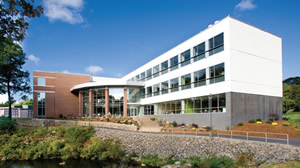
PHOTOS © SHELLY HARRISON PHOTOGRAPHY
There may also exist commitments and
obligations with labor unions that must
be honored. “There are workarounds,”
explains Fulton, “like having the private
entity hire the workers with the same benefits package, or allow them to retain union status. Still, it can
be a thorny issue.”
Fulton admits the biggest challenge to the P3 model is
cultural acceptance. “This is not a robust liquid market where it
happens all the time. Adoption is slow.”
Gilbride agrees. “Public institution facility staff often reacts to
proposed P3 projects with a mixture of ‘you can’t get there from
here’ and the proverbial ‘deer in the headlights’ look,” he writes.

PHOTOS © SHELLY HARRISON PHOTOGRAPHY
Endicott College:
A Fruitful Partnership
Endicott College, a small private school
in Beverly, MA, was on the verge of bankruptcy
when Dr. Richard Wylie assumed
the presidency in 1987. Instead of winding
down the two-year women’s college,
he planted $25,000 worth of flowers. This
commitment to the physical plant, along
with a shift to a four-year, co-ed program,
saved Endicott. In the last 10 years it’s
doubled its landmass as it added new programs
and buildings to house them.
For the first 20-plus years of this rebirth,
Endicott used the classic hard bid approach
to project delivery. In this model a public bid
goes out to contractors who win a project by
submitting the lowest bid. In 2008 Endicott
began partnering with Windover Construction
to provide pre-design, preconstruction
and construction services.
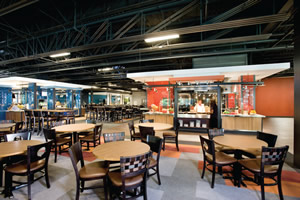
PHOTOS © SHELLY HARRISON PHOTOGRAPHY
Since then Windover has built more than
12 structures on campus. “Their strategy
or pre-planning and budgeting has made
construction on-campus a very positive
experience,” quotes Dr. Wylie.
Their latest project for Endicott, the
Callahan Student Center and Dining Hall,
was an important project with many
challenges. The college needed to double
the size of the existing center and update
an inadequate dining hall. As the center
of student life and only real food service
option on campus, closing the mid-1960s
building for construction was not possible.
Replacement seemed like the logical
choice. But Endicott is located on the
water, on the Atlantic coast, making available
land scarce. And of course the budget
was tight. “We were at the table early in
the process to study the cost of replacement
versus renovation and expansion,”
says Lee Dellicker, president and CEO,
Windover.
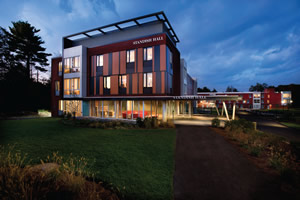
PHOTOS © SHELLY HARRISON PHOTOGRAPHY
Windover came up with a phased
construction schedule that kept the student/dining center up and running during the entire
13-and-a-half months of construction.
“Yes, it would have been cheaper to tear the
structure down and rebuild, but they had to
keep operating,” explains Dellicker.
Endicott College has gone through a
growth spurt over the last seven to eight
years, adding $100 million worth of
buildings. Windover has helped deliver
these projects as a partner, creating an ice
rink, student housing and a three-story
academic building that hosts both a science
and business curriculums.
The construction management approach,
“doesn’t just build buildings. It
identifies needs and solves problems,” according
to Dellicker. “It’s more economical,
saner and more fun.”
This article originally appeared in the College Planning & Management September 2016 issue of Spaces4Learning.